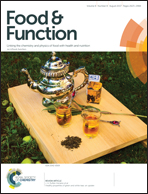Healthy properties of green and white teas: an update
Abstract
Green tea has been consumed for centuries in Japan, China and Morocco. White tea, which is considered a variety of green tea, is mostly consumed in China and is very appreciated for its flavor. Currently the consumption of both types of tea has been extended to the western countries even as a functional ingredient. A group of polyphenols called catechins stands out among their bioactive components, the most abundant being the (−) epigallocatechin gallate, with high antioxidant power. Teas also contain other phenolic compounds such as gallic, caffeic, chlorogenic or cinnamic acids, quercetin and proanthocyanidols, caffeine, theophylline, L-theanine and minerals such as fluorine, manganese or chromium. Investigations have mainly been focused on their antioxidant potential and their implication in the prevention and treatment of degenerative diseases. Several studies have evaluated their role in cardiovascular diseases, body weight control, bone mass increase, protection against neurodegenerative diseases and improvement of type 2 diabetes, among other pathologies. The main points of controversy are the design and interpretation of epidemiological and human intervention studies and the lack of information on catechins availability, metabolism and biotransformation. This review compiles and analyzes the latest peer-reviewed papers published from 2002 up to February 2017, including systematic reviews and meta-analyses.



 Please wait while we load your content...
Please wait while we load your content...